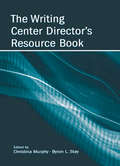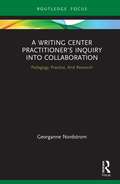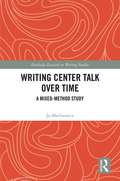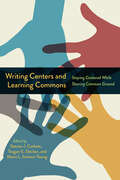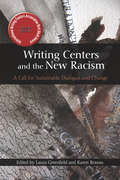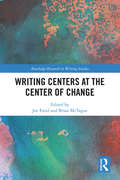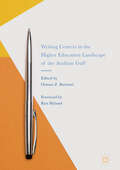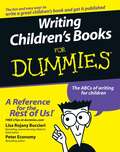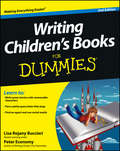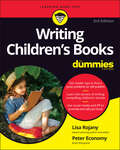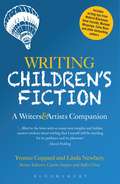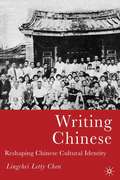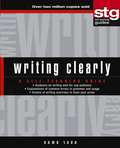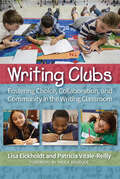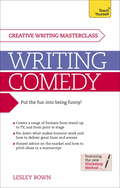- Table View
- List View
The Writing Center Director's Resource Book
by Christina Murphy Byron L. StayThe Writing Center Director's Resource Book has been developed to serve as a guide to writing center professionals in carrying out their various roles, duties, and responsibilities. It is a resource for those whose jobs not only encompass a wide range of tasks but also require a broad knowledge of multiple issues.The volume provides information on the most significant areas of writing center work that writing center professionals--both new and seasoned--are likely to encounter. It is structured for use in diverse institutional settings, providing both current knowledge as well as case studies of specific settings that represent the types of challenges and possible outcomes writing center professionals may experience. This blend of theory with actual practice provides a multi-dimensional view of writing center work.In the end, this book serves not only as a resource but also as a guide to future directions for the writing center, which will continue to evolve in response to a myriad of new challenges that will lie ahead.
A Writing Center Practitioner's Inquiry into Collaboration: Pedagogy, Practice, And Research (Routledge Research in Writing Studies)
by Georganne NordstromThis book presents a model of Practitioner Inquiry (PI) as a systematic form of empirical research and provides a rationale for its suitability within a writing center context. Exploring the potential of writing centers as pedagogical sites that support research, the book offers an accessible model that guides both research and practice for writing center practitioners, while offering flexibility to account for their distinct contexts of practice. Responding to the increasing call in the field to produce empirical “RAD” (replicable, aggregable, data-driven) research, the author explores Practitioner Inquiry through explication of methodology and methods, a revisitation of collaboration to guide both practice and research, and examples of application of the model. Nordstrom grounds this research and scholarship in Hawaiʻi’s context and explores Indigenous concepts and approaches to inform an ethical collaborative practice. Offering significant contributions to empirical research in the fields of writing center studies, composition, and education, this book will be of great relevance to writing center practitioners, anyone conducting empirical research, and researchers working in tutor professionalization, collaboration, translingual literacy practices, and researchmethodologies.
A Writing Center Practitioner's Inquiry into Collaboration: Pedagogy, Practice, And Research (Routledge Research in Writing Studies)
by Georganne NordstromThis book presents a model of Practitioner Inquiry (PI) as a systematic form of empirical research and provides a rationale for its suitability within a writing center context. Exploring the potential of writing centers as pedagogical sites that support research, the book offers an accessible model that guides both research and practice for writing center practitioners, while offering flexibility to account for their distinct contexts of practice. Responding to the increasing call in the field to produce empirical “RAD” (replicable, aggregable, data-driven) research, the author explores Practitioner Inquiry through explication of methodology and methods, a revisitation of collaboration to guide both practice and research, and examples of application of the model. Nordstrom grounds this research and scholarship in Hawaiʻi’s context and explores Indigenous concepts and approaches to inform an ethical collaborative practice. Offering significant contributions to empirical research in the fields of writing center studies, composition, and education, this book will be of great relevance to writing center practitioners, anyone conducting empirical research, and researchers working in tutor professionalization, collaboration, translingual literacy practices, and researchmethodologies.
Writing Center Research: Extending the Conversation
by Paula Gillespie Alice Gillam Lady Falls Brown Byron StayThere are writing centers at almost every college and university in the United States, and there is an emerging body of professional discourse, research, and writing about them. The goal of this book is to open, formalize, and further the dialogue about research in and about writing centers. The original essays in this volume, all written by writing center researchers, directly address current concerns in several ways: they encourage studies, data collection, and publication by offering detailed, reflective accounts of research; they encourage a diversity of approaches by demonstrating a range of methodologies (e.g., ethnography, longitudinal case study; rhetorical analysis, teacher research) available to both veteran and novice writing center professionals; they advance an ongoing conversation about writing center research by explicitly addressing epistemological and ethical issues. The book aims to encourage and guide other researchers, while at the same time offering new knowledge that has resulted from the studies it analyzes.
Writing Center Research: Extending the Conversation
by Paula Gillespie Alice Gillam Lady Falls Brown Byron StayThere are writing centers at almost every college and university in the United States, and there is an emerging body of professional discourse, research, and writing about them. The goal of this book is to open, formalize, and further the dialogue about research in and about writing centers. The original essays in this volume, all written by writing center researchers, directly address current concerns in several ways: they encourage studies, data collection, and publication by offering detailed, reflective accounts of research; they encourage a diversity of approaches by demonstrating a range of methodologies (e.g., ethnography, longitudinal case study; rhetorical analysis, teacher research) available to both veteran and novice writing center professionals; they advance an ongoing conversation about writing center research by explicitly addressing epistemological and ethical issues. The book aims to encourage and guide other researchers, while at the same time offering new knowledge that has resulted from the studies it analyzes.
Writing Center Talk over Time: A Mixed-Method Study (Routledge Research in Writing Studies)
by Jo MackiewiczIn the last 15 to 20 years, writing centers have placed greater importance on tutor training, focusing on teaching tutors best practices in fostering student writers’ engagement and writing skills. Writing Center Talk over Time explores the importance of writing center talk and demonstrates the efficacy of tutor training. The book uses corpus-driven analysis and discourse analysis to examine the changes in writing center talk over time to provide a baseline understanding of the very heart of writing center work: the talk that unfolds between tutors and student writers. It is this talk that, at its best, motivates student writers to continue to improve their writing and scaffolds their learning and that makes tutors proud of the service that they provide. The methods and analysis of this study are intended to inform other researchers so that they may conduct further research into the efficacy of writing center talk.
Writing Center Talk over Time: A Mixed-Method Study (Routledge Research in Writing Studies)
by Jo MackiewiczIn the last 15 to 20 years, writing centers have placed greater importance on tutor training, focusing on teaching tutors best practices in fostering student writers’ engagement and writing skills. Writing Center Talk over Time explores the importance of writing center talk and demonstrates the efficacy of tutor training. The book uses corpus-driven analysis and discourse analysis to examine the changes in writing center talk over time to provide a baseline understanding of the very heart of writing center work: the talk that unfolds between tutors and student writers. It is this talk that, at its best, motivates student writers to continue to improve their writing and scaffolds their learning and that makes tutors proud of the service that they provide. The methods and analysis of this study are intended to inform other researchers so that they may conduct further research into the efficacy of writing center talk.
Writing Centers and Learning Commons: Staying Centered While Sharing Common Ground
Writing Centers and Learning Commons presents program administrators, directors, staff, and tutors with theoretical rationales, experiential journeys, and go-to practical designs and strategies for the many questions involved when writing centers find themselves operating in shared environments. The chapters comprehensively examine the ways writing centers make the most of sharing common ground. Directors, coordinators, administrators, and stakeholders draw on past and present attention to writing center studies to help shape the future of the learning commons and narrate their substantial collective experience with collaborative efforts to stay centered while empowering colleagues and student writers at their institutions. The contributors explore what is gained and lost by affiliating writing centers with learning commons, how to create sound pedagogical foundations that include writing center philosophies, how writing center practices evolved or have been altered by learning center affiliations, and more. Writing Centers and Learning Commons is for all stakeholders of writing in and across campuses collaborating on (by choice or edict), or wishing to explore the possibilities of, a learning commons enterprise. Contributors: Alice Batt, Cassandra Book, Charles A. Braman, Elizabeth Busekrus Blackmon, Virginia Crank, Celeste Del Russo, Patricia Egbert, Christopher Giroux, Alexis Hart, Suzanne Julian, Kristen Miller, Robby Nadler, Michele Ostrow, Helen Raica-Klotz, Kathleen Richards, Robyn Rohde, Nathalie Singh-Corcoran, David Stock
Writing Centers and the New Racism: A Call for Sustainable Dialogue and Change
by Greenfield, Laura; Rowan, KarenNoting a lack of sustained and productive dialogue about race in university writing center scholarship, the editors of this volume have created a rich resource for writing center tutors, administrators, and scholars. Motivated by a scholarly interest in race and whiteness studies, and by an ethical commitment to anti-racism work, contributors address a series of related questions: How does institutionalized racism in American education shape the culture of literacy and language education in the writing center? How does racism operate in the discourses of writing center scholarship/lore, and how may writing centers be unwittingly complicit in racist practices? How can they meaningfully operationalize anti-racist work? How do they persevere through the difficulty and messiness of negotiating race and racism in their daily practice? The conscientious, nuanced attention to race in this volume is meant to model what it means to be bold in engagement with these hard questions and to spur the kind of sustained, productive, multi-vocal, and challenging dialogue that, with a few significant exceptions, has been absent from the field.
Writing Centers at the Center of Change (Routledge Research in Writing Studies)
by Joe Essid Brian McTagueWriting Centers at the Center of Change looks at how eleven centers, internationally, adapted to change at their institutions, during a decade when their very success has become a valued commodity in a larger struggle for resources on many campuses. Bringing together both US and international perspectives, this volume offers solutions for adapting to change in the world of writing centers, ranging from the logistical to the pedagogical, and even to the existential. Each author discusses the origins, appropriate responses, and partners to seek when change comes from within a school or outside it. Chapters document new programs being formed under changing circumstances, and suggest ways to navigate professional or pedagogical changes that may undermine the hard work of more than four decades of writing-center professionals. The book’s audience includes writing center and learning-commons administrators, university librarians, deans, department chairs affiliated with writing centers. It will also be useful for graduate students in composition, rhetoric, and academic writing.
Writing Centers at the Center of Change (Routledge Research in Writing Studies)
by Joe Essid Brian McTagueWriting Centers at the Center of Change looks at how eleven centers, internationally, adapted to change at their institutions, during a decade when their very success has become a valued commodity in a larger struggle for resources on many campuses. Bringing together both US and international perspectives, this volume offers solutions for adapting to change in the world of writing centers, ranging from the logistical to the pedagogical, and even to the existential. Each author discusses the origins, appropriate responses, and partners to seek when change comes from within a school or outside it. Chapters document new programs being formed under changing circumstances, and suggest ways to navigate professional or pedagogical changes that may undermine the hard work of more than four decades of writing-center professionals. The book’s audience includes writing center and learning-commons administrators, university librarians, deans, department chairs affiliated with writing centers. It will also be useful for graduate students in composition, rhetoric, and academic writing.
Writing Centers in the Higher Education Landscape of the Arabian Gulf
by Osman Z. BarnawiThis book addresses issues surrounding writing centers in the Arabian Gulf region. Including a foreword by Professor Ken Hyland, it brings together a number of thought-provoking chapters on the history, concept, and ground realities coupled with critical comparative discussions of writing centres in the region. The book begins by offering critical historical accounts of writing centers in the Gulf countries, before moving onto empirical research and reports on pedagogical practices that vividly capture the on-the-ground realities faced and experienced by different actors. These accounts serve to highlight how the writing centers vary between countries, as well as how they differ from the more well-known writing centers in the US and the UK. Finally, the book explores what sort of commonalities and differences the current trend of writing centres is producing within and between the six countries of the Arabian Gulf. This book will be highly relevant to those involved with writing centres along with directors, policymakers, researchers and teacher educators in the fields of Education and Sociology, particularly those with an interest in the Arabian Gulf area.
Writing Children's Books For Dummies
by Lisa Rojany Buccieri Peter EconomyEveryone loves a children's book. And many dream about writing one. But is it actually possible for an unpublished writer—armed with a good story idea and a love of kids—to write, sell, publish, and promote a book? Yes, it is! Veteran children's book publishing executive and author Lisa Rojany Buccieri and author Peter Economy show you how, in their incredibly useful 2005 first edition of Writing Children's Books For Dummies®. Buccieri and Economy begin by explaining the basics of the children's book business, from the nuts and bolts of the various formats and genres—with helpful illustrations to aid you—to the intricacies of the book publishing market, a list of recent award-winning books, and a first peek into the particular mind set that writing children's books requires. (Hint: Throw out the adult rules, and think like a kid!) Then the authors dive into the actual writing process itself, with tips on setting up a workspace, brainstorming great book ideas, researching the subject you decide on, even speaking with the sorts of kids you hope will eventually read the book. They show you how to create compelling characters and develop them in the manuscript; how to outline and write a plot "arc" of conflict, change, and resolution; how to master the difficult art of writing dialogue; and how to use active (rather than passive) language to keep your story moving along and interesting to young minds. Or, if you're planning to write a creative nonfiction children's book—on a topic such as science, nature, or a historical figure, for example—the authors include a chapter on this, too. Ready, set, go… it's time to sit down and write! Once you've finished your book, however, the process has only begun. Now you will refine, submit, and hopefully sell your manuscript. Here again, the authors of Writing Children's Books For Dummies come through for you. They deliver solid advice on hiring an illustrator—or not; participating in workshops and conferences to learn the business and hone a story; finding an agent; and, finally, submitting the manuscript to publishers and—if you are successful—signing a contract. Along the way, the authors also include tips on handling rejection; a quick primer on the various editors in publishing houses (and how they work to make your book its best); and making a plan to publicize the book, including hiring a publicist if necessary. Like all For Dummies® books, Writing Children's Books For Dummies highlights "The Part of Tens," which includes the Ten Best Ways to Promote Your Story and More Than Ten Great Sources for Storylines. And the ever-helpful Cheat Sheet includes Tips for Editing your Children's Book Manuscript, Children's Book No-No's, Twelve Commandments for Writing Younger Children's Books, and Tips on Promotion. From setting down that first word on paper to doing a successful publicity tour, Writing Children's Books For Dummies gives you the confidence and the insiders' know-how to write and sell the story you've always wanted to write.
Writing Children's Books For Dummies
by Lisa Rojany Buccieri Peter EconomyEverything aspiring authors need to write, publish, and sell a children's book Everyone loves a children's book—and many dream about writing one. But is it actually possible for an unpublished writer—armed with a good story idea and a love of kids—to write, sell, publish, and promote a book? Yes, it is! Clearly and concisely written with straightforward advice and a plethora of specific up-to-date recommendations, Writing Children's Books For Dummies provides step-by-step information on everything aspiring children's book authors need to know—from researching the current marketplace to developing story ideas, strengthening writing skills, dealing with editors, and submitting proposals and manuscripts to agents and publishers. Updated and improved writing exercises All new content on social media and establishing an online presence as an author Fresh, updated content on publishing via hard copy and all the e- platforms From setting down that first word on paper to doing a successful publicity tour, Writing Children's Books For Dummies gives you the confidence and the insiders' know-how to write and sell the story you've always wanted to write.
Writing Children's Books For Dummies
by Lisa Rojany Buccieri Peter EconomyEverything aspiring authors need to write, publish, and sell a children's book Everyone loves a children's book—and many dream about writing one. But is it actually possible for an unpublished writer—armed with a good story idea and a love of kids—to write, sell, publish, and promote a book? Yes, it is! Clearly and concisely written with straightforward advice and a plethora of specific up-to-date recommendations, Writing Children's Books For Dummies provides step-by-step information on everything aspiring children's book authors need to know—from researching the current marketplace to developing story ideas, strengthening writing skills, dealing with editors, and submitting proposals and manuscripts to agents and publishers. Updated and improved writing exercises All new content on social media and establishing an online presence as an author Fresh, updated content on publishing via hard copy and all the e- platforms From setting down that first word on paper to doing a successful publicity tour, Writing Children's Books For Dummies gives you the confidence and the insiders' know-how to write and sell the story you've always wanted to write.
Writing Children's Books For Dummies
by Lisa Rojany Peter EconomyCreate the next very hungry caterpillar, big red dog, or cat in the hat with a hand from this trusted guide In Writing Children’s Books For Dummies, you’ll learn what to write between “Once upon a time . . .” and “The End” as you dive into chapters about getting started writing, how to build great characters, and how to design a dramatic plot. On top of the technical writing advice, you’ll discover how talented illustrators work and how to find an agent. The newest edition of this popular For Dummies title even shows you how to choose a publisher—or self-publish—and how to use social media and other marketing and PR to get the word out about your new masterpiece. In the book, you’ll learn about: The fundamentals of writing for children, including common book formats and genres, and the structure of the children’s book market Creating a spellbinding story with scene description, engaging dialogue, and a child-friendly tone Polishing your story to a radiant shine with careful editing and rewriting Making the choice between a traditional publisher, a hybrid publisher, or self-publishing Using the most-effective marketing and publicity techniques to get your book noticed Perfect for anyone who’s ever dreamed of creating the next Ferdinand the Bull or Grinch, Writing Children’s Books For Dummies is an essential, easy-to-read guide for budding children’s authors everywhere.
Writing Children's Books For Dummies
by Lisa Rojany Peter EconomyCreate the next very hungry caterpillar, big red dog, or cat in the hat with a hand from this trusted guide In Writing Children’s Books For Dummies, you’ll learn what to write between “Once upon a time . . .” and “The End” as you dive into chapters about getting started writing, how to build great characters, and how to design a dramatic plot. On top of the technical writing advice, you’ll discover how talented illustrators work and how to find an agent. The newest edition of this popular For Dummies title even shows you how to choose a publisher—or self-publish—and how to use social media and other marketing and PR to get the word out about your new masterpiece. In the book, you’ll learn about: The fundamentals of writing for children, including common book formats and genres, and the structure of the children’s book market Creating a spellbinding story with scene description, engaging dialogue, and a child-friendly tone Polishing your story to a radiant shine with careful editing and rewriting Making the choice between a traditional publisher, a hybrid publisher, or self-publishing Using the most-effective marketing and publicity techniques to get your book noticed Perfect for anyone who’s ever dreamed of creating the next Ferdinand the Bull or Grinch, Writing Children’s Books For Dummies is an essential, easy-to-read guide for budding children’s authors everywhere.
Writing Children's Fiction: A Writers' and Artists' Companion (Writers’ and Artists’ Companions)
by Linda Newbery Yvonne CoppardFull of both inspirational and practical advice, Writing Children's Fiction: A Writers' and Artists' Companion is an essential guide to writing for some of the most difficult and demanding readers of all: children and young people.Part 1 explores the nature, history and challenges of children's literature, and the amazing variety of genres available for children from those learning to read to young adults.Part 2 includes tips by such bestselling authors as David Almond, Malorie Blackman, Meg Rosoff and Michael Morpurgo.Part 3 contains practical advice - from shaping plots and creating characters to knowing your readers, handling difficult subjects and how to find an agent and publisher when your book or story is complete.
Writing Children's Fiction: A Writers' and Artists' Companion (Writers’ and Artists’ Companions)
by Linda Newbery Yvonne CoppardFull of both inspirational and practical advice, Writing Children's Fiction: A Writers' and Artists' Companion is an essential guide to writing for some of the most difficult and demanding readers of all: children and young people.Part 1 explores the nature, history and challenges of children's literature, and the amazing variety of genres available for children from those learning to read to young adults.Part 2 includes tips by such bestselling authors as David Almond, Malorie Blackman, Meg Rosoff and Michael Morpurgo.Part 3 contains practical advice - from shaping plots and creating characters to knowing your readers, handling difficult subjects and how to find an agent and publisher when your book or story is complete.
Writing Chinese: Reshaping Chinese Cultural Identity
by L. ChenThis is a comparative study of the politics of Chinese cultural identity facing China, Taiwan, Hong Kong, the US-Chinese, and the Chinese diaspora in the West. The author challenges current discussions of hybridity and nationalism by contrasting the experiences of Taiwan, Hong Kong and US-Chinese with those of China and the Chinese diaspora.
Writing Clearly: A Self-Teaching Guide (Wiley Self-Teaching Guides #160)
by Dawn SovaImprove your writing skills at your own pace How do you target a specific audience in writing? What makes up a strong thesis statement? Is there a trick to maintaining clear communication in cyberspace? How do you achieve unity and coherence in a final draft? With Writing Clearly: A Self-Teaching Guide, you'll discover the answers to these questions and many more about the basics of communicating effectively through the written word. Each chapter in this hands-on guide focuses on key steps in the writing process, identifying the shared and differing skills demanded by each type of writing, be it a persuasive essay, a business letter, or a scientific report. The straightforward, structured format of Writing Clearly makes it fully accessible, providing an easy-to-understand, comprehensive overview for everyone-from students beginning to build skills, to adults looking to improve their writing, to the experienced writer hoping to further hone skills in a certain area. Like all Self-Teaching Guides, Writing Clearly allows you to build gradually on what you have learned-at your own pace. Questions and self-tests reinforce the information in each chapter and allow you to skip ahead or focus on specific areas of concern. Packed with useful, up-to-date information, this clear, concise volume is a valuable learning tool and reference source for anyone who wants to develop or improve his or her basic writing skills.
Writing Clubs: Fostering Community, Collaboration, and Choice in the Writing Classroom
by Lisa Eickholdt Patricia Vitale-ReillyAsk teachers about their biggest challenges in elementary and middle school, and many will say the teaching of writing. It is often difficult for students find the joy, discovery, and satisfaction writing can yield. What Lisa Eickholdt and Patricia Vitale-Reilly have found is that adherence to genre studies can get in the way of student collaboration. Believing writing instruction should be more authentic, they want students to have more choices, develop better collaboration, and sustain a sense of community, all through the implementation of writing clubs.In their book Writing Clubs: Fostering Choice, Collaboration, and Community in the Writing Classroom , you'll discover ways to: Collaborate throughout the process of writing Choose what to write and how to write it Examine mentor texts and study craft techniques across genres Develop speaking and listening skills Celebrate classmates&’ accomplishments through publication Collaboration is widely recognized as a vital life skill. Eickholdt and Vitale-Reilly present a plethora of ideas on how gratifying it can be right now, as well as in the future. There&’s an old proverb that says, &‘If you want to go fast, go alone. If you want to go far, go with others.&’ In Writing Clubs , we discover that there is no limit to how far young writers can go when teachers show them what it means to collaborate.
Writing Clubs: Fostering Community, Collaboration, and Choice in the Writing Classroom
by Lisa Eickholdt Patricia Vitale-ReillyAsk teachers about their biggest challenges in elementary and middle school, and many will say the teaching of writing. It is often difficult for students find the joy, discovery, and satisfaction writing can yield. What Lisa Eickholdt and Patricia Vitale-Reilly have found is that adherence to genre studies can get in the way of student collaboration. Believing writing instruction should be more authentic, they want students to have more choices, develop better collaboration, and sustain a sense of community, all through the implementation of writing clubs.In their book Writing Clubs: Fostering Choice, Collaboration, and Community in the Writing Classroom , you'll discover ways to: Collaborate throughout the process of writing Choose what to write and how to write it Examine mentor texts and study craft techniques across genres Develop speaking and listening skills Celebrate classmates&’ accomplishments through publication Collaboration is widely recognized as a vital life skill. Eickholdt and Vitale-Reilly present a plethora of ideas on how gratifying it can be right now, as well as in the future. There&’s an old proverb that says, &‘If you want to go fast, go alone. If you want to go far, go with others.&’ In Writing Clubs , we discover that there is no limit to how far young writers can go when teachers show them what it means to collaborate.
Writing Combat and the Self in Early Modern English Literature: The Pen and the Sword (Early Modern Cultural Studies 1500–1700)
by Jennifer FeatherBy examining these competing depictions of combat that coexist in sixteenth-century texts ranging from Arthurian romance to early modern medical texts, this study reveals both the importance of combat in understanding the humanist subject and the contours of the previously neglected pre-modern subject.
Writing Comedy: How to use funny plots and characters, wordplay and humour in your creative writing
by Lesley BownLearn how to write comedy that makes people laugh.Masterclass: Writing Comedy will reveal to both beginners and experienced writers the distinctive features that mark out comedy from other forms of creative writing. Having identified these, it will help you then to unlock your inner anarchist, and explore the different elements of comedy, using a combination of practical exercises, insight and creative inspiration. Whatever your preferred comic genre, you will find guidance on everything from wordplay and visual humour to plots, comedy characters and different styles.A section on performance will help you to hone stand-up skills, while chapters on stage and screen will give techniques and tips on how to craft a sitcom or create a sketch show. Finally, there is a uniquely frank but useful section on the realities of the markets, and the actualities of going it alone with self-publishing and self-promotion - or the tools you need to successfully pitch an idea or comic manuscript.ABOUT THE SERIESThe Teach Yourself Creative Writing series helps aspiring authors tell their stories. Covering a range of genres from science fiction and romantic novels to illustrated children's books and comedy, this series is packed with advice, exercises, and tips for unlocking creativity and improving your writing. And because we know how daunting the blank page can be, we set up the Just Write online community, at tyjustwrite.com, for budding authors and successful writers to connect and share.
